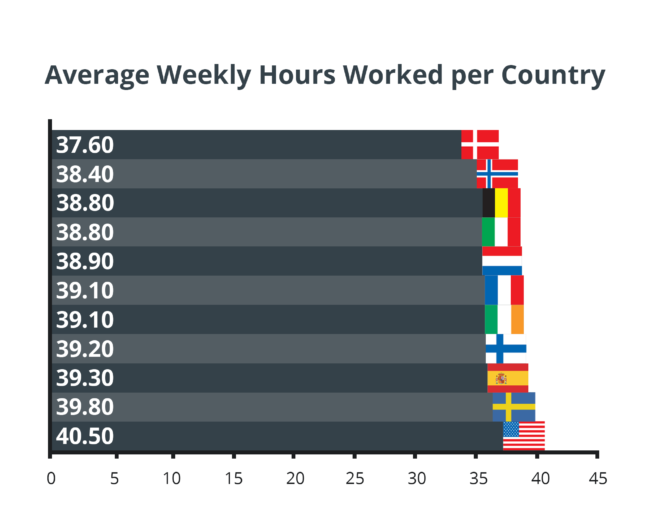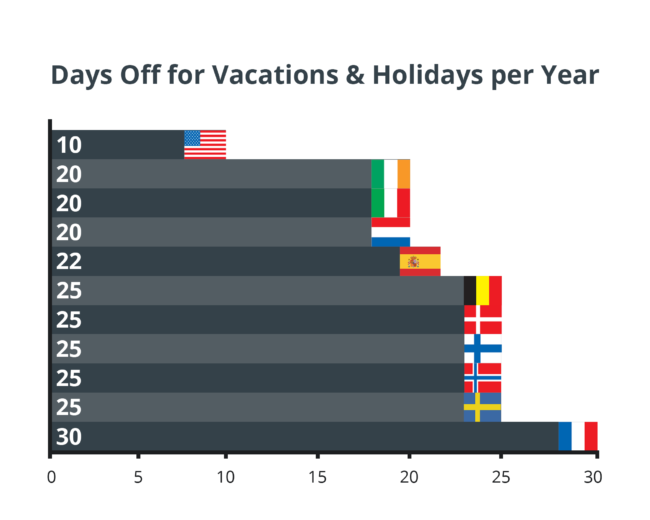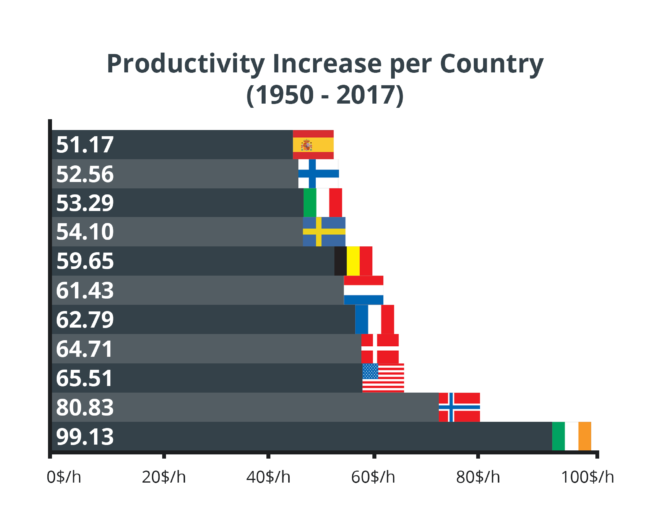The Benefits of a Four Day Work Week
Across Europe, the four-day work week trend is popular. From the Spanish government encouraging shorter weeks, to large companies across the globe trialling it as a phased return to the office, four-day work weeks are being discussed as a way to improve wellbeing and productivity, along with other benefits.
In 1956, Richard Nixon, then Vice President, said that through the continuation of his administration’s economic policies, he foresaw a “four-day work week and a fuller family life for every American.” Not since the 1920’s, when a five-day work week was adopted after Henry Ford, has such a workplace revolution taken place.
There is, however, a barrier to this revolution. There is growing concern from employers, especially those in the Baby Boomers and Gen X (38-55+) categories, over the introduction of a four-day work week and the potential impact it could have on the customer experience and their competitiveness with other businesses from the same industry.
The four-day work week has highlighted how the workplace can change meaningfully without impacting productivity levels. So, what are the benefits of the four-day work week?
The European Four-Day Work Week and Happiness
Across Europe, the shorter working hours in many countries and stricter laws around benefits, compensation and more have led to consistently higher rankings in the World Happiness Report Ranking over traditional countries like the USA.
In 2021, the USA ranked 19th in happiness, but it had declined since 2019 where it was ranked globally in position 18th. Comparatively, Scandinavian states such as Finland, Denmark and Switzerland are consistently at the top of the board, along with many other European countries offering more flexible employment benefits and forms of compensation.
Countries with a Reduced Work Week
Countries like the Netherlands already have a shorter working week (on average across full and part time employees), and many other countries, such as Spain have begun to trial it in some departments across government.
The interesting thing to consider, however, is the impact of a shorter working week average compared to the overall emotional wellbeing of a country. Data taken from Eurostat for full time employees average hours worked vs the Gallup World Poll and World Happiness Report (Figure 2.1) is shown below
Data analysis specialists commented:
“Turkey has the highest average weekly hours with 47.5 hours & the lowest ranking of happiness at 4.862. However, Iceland (42.9/7.575) & Switzerland (41.8/7.508) also have high weekly working hours, but they are within the top 4 countries in 2020 ranking of happiness.”
Companies Offering a Four Day Work Week
While some big-name organizations are trialling four-day work weeks, including high-profile brands like Microsoft and Unilever, many other companies are either already offering four-day work weeks to their employees or investigating it what it could mean for their workplace.
Henley Business School research suggests that flexible working practices are typically offered to management roles. This follows a pattern whereby senior managers are offered more flexible schedules to deliver tasks and projects with fewer restraints, such as working remotely or reduced (or sometimes longer) work weeks.
In the US, for example, worker classification can impact the work week. Instead of a traditional working practice, exempt employees work until tasks and projects are completed, rather than within defined hours.
What are the Average Weekly Hours Worked?
Data analysed from the Our World in Data demonstrates the race for completing a work week, as visualised in average working hours. This indicates how countries’ work weeks compare in hours worked, where the USA records the longest week.

Days Off Per Year
Comparatively, “days off” (including holidays and vacation allowance) shows a reverse trend in some instances, where certain countries with long working weeks correlate with those with shorter leave allowances.
Not in all circumstances does the working week correlate with vacation and other leave entitlements, but it does demonstrate where employees are working longer and with reduced leave benefits.

Productivity Increase (1950 – 2017)
Between the years of 1950 and 2017, all countries recorded a rise in productivity levels. Some countries, such as the US and Denmark, saw a sharp climb in labour productivity. Those with a four-day workweek, importantly, have not recorded a dip in productivity.

Reduction in Hours
Lastly, reductions in hours shows countries that have, over time, limited the length of a working week. With discussions of a four-day work week, it helps visualise those countries where the working week has already reduced.

The Benefits of a Four Day Work Week
It can be difficult to measure the benefits associated with a four-day work week. However, research suggests largely positive outcomes where countries or businesses have successfully deployed a four-day work week.
A comprehensive study of over 2000 UK businesses conducted Henley Business School, titled ‘Four Better or Four Worse’, discovered many benefits of a four-day work week when it was advertised as part of a company’s employee package.
The benefits included:
- Companies can more effectively attract and retain talent
- Increases in employee satisfaction
- Reduced employee sickness levels
- Improved productivity
Pros of a Four Day Work Week
1) Attraction and Retention of Employees
A large proportion of those who have deployed a four-day week stated a positive trend towards attracting employees with caring responsibilities or children (71%) or older employees (70%).
Four day work weeks have long been championed by working parents, especially since there are growing concerns around the impact that career gaps have on the female workforce and their ability to progress to higher level C-Suite roles. This more flexible approach to working life allows parents to raise children and progress their careers in a healthy balance, thereby reducing stress on their mental and professional wellbeing.
2) Employees are Happier
Having an extra day off in the week allows employees to focus on their personal lives, reduce stress, and spend even more time with family and friends. As a result, employees on a four-day work week often report an increase in productivity, and more importantly, a reduction in sick days. Having extended time off, employees can destress more easily and are likely to suffer less from mental or physical strain.
3) Significant Cost Savings
UK businesses implementing a four-day work week can expect greater cost savings. A combined cost saving of up to £92 billion has been reported, or 2% of the annual turnover.
But how is the four-day work week more cost-effective?
Companies will save from reduced overhead associated with running facilities, such as electricity, and where employees are productive and less likely to take sick leave absence.
Case Study: US Companies with a Four Day Work Week
In 2019, Microsoft Japan closed their office every Friday in August as part of an experiment to see if it would positively impact their workforce. They also instigated 30-minute meetings and encouraged remote meetings during this time.
Labour productivity increased by 39.9% (YoY) during this time, and electricity and printing savings were also noted.
Cons of a Four Day Work Week
Despite the potential of a competitive advantage, a study from the Harvard Business Review noticed a hesitation from seniority role to embrace the four-day work week. In total, 73% of leaders have concerns over reducing a work week, citing the following issues:
- Regulations and compliance with contracts
- Staffing challenges
- Challenges from internal bureaucracy
A major anxiety was the availability of support for customers, and whether these needs would be let down by such an experiment. Whilst this concern was reported by 82% of businesses, it was not a perceived issue by employees, where only 21% foresee issues with troubled customer care.
Professor Anupam Nanda, Professor of Urban Economics and Real Estate at Henley Business School, observed how this might be an issue for the UK:
“The UK economy is service dominated, and with significant internationalisation in the service sector, when many other parts of the world are working on five days a week, there are implications for companies with global platforms and connections if the UK changes to a four-day week.”
1) Customer Support
Many employers are concerned that their customer-focus will decline if reduced hours were deployed in the workplace, especially in smaller businesses with lower headcounts. With less resource available to SMEs for staff cover, there may not be enough employees to make a four-day week practical or effective, especially in service-based industries where there is a demand for regular customer care.
Often hesitant perceptions of how a reduced four-day work week might undermine an industry is enough rationale for employers to not even explore the benefits and possibilities. But if your business has a reputation and brand for its customer care, then reducing working hours might not seem practical.
2) Employee Perception
Perceptions of change are always challenging how a workplace can evolve.
For those employees who might request a reduced working week, there nay be a stigma attached. Reduced hours or shorter work weeks may, for example, lead to a perception that work productivity is less important.
Case Study: US Company TreeHouse Scraps Four Day Work Week
In the US, many companies have unsuccessfully trialled a four-day work week.
Food and drinks manufacturer, TreeHouse Foods Inc, found that they were struggling competitively after experimenting with shorter work weeks. As a result, the company laid off 22 employees and reinstated a full, five-day work week.
The entrepreneur and business owner was previously working 32 hour work weekly, transitioning back to 65 hours a week. Reflecting the four-day work week, he observed how, “I think you can work smarter, but I don’t think you can not work harder. You’ve got to do both.”
How Does America Compare?
The USA approach to work-life, the balance of exempt vs non-exempt employees, in addition to the lack of federal guidance, has contributed to the struggle of adapting to more flexible policies. Many experts have suggested that the hardworking culture in America, along with missing policies in employee wellbeing, all contribute to the ongoing struggle to embrace a four-day work week.
Implementing A Four Day Work Week: A Pragmatic Approach
Businesses from a variety of sectors and siloes may wonder how to practically implement a four-day work week, and how they can successfully benchmark its adoption.
Embrace technology
The availability of technology, paired with increasing ease of use and accessibility means that technology can be used to easily blend four-day work weeks cleverly. Technology could be used to:
- Create scheduling planners to know who is at work when and manage shift patterns with ease.
- Sort through enquiries submitted online and provide an online help directory where possible.
- Limit meeting times and introduce remote meetings. While this may have been introduced in pandemic situations, bringing this forward as the office reopens encourages flexible approaches.
Begin gradually
No good project was ever done overnight and implementing gradual changes in a workforce schedule will help to increase the potential for success.
You could begin by closing the office earlier on a Friday for everyone and ensuring that a company is able to manage this in the long term before reducing it even further.
Manage KPI’s
Using one or more Key Performance Indicators will allow you to not only understand the positive changes a four-day work week could bring, but also areas that you may need to improve to ensure success.
These could be:
- Sales leads brought in
- Tasks completed on time
- Employee/Employer/Client NPS scores
- Project Delivery Rate
- Time spent online by employees
Choosing targets to maintain or overachieve will not only create a quantifiable approach but can also show long and short-term impacts of such a change.
Create Agile Payroll
To adapt to a more flexible workweek, a technology driven, adaptive payroll must be considered to create a system that works for everyone. Consider using timesheet-based payroll, or task based for those currently on hourly pay. Salaried employees should see no change.
Tech Disruption Brings About Increased Productivity and Potential for Change
Starting in the late 2000’s the disruption of technology, big data and automation has meant that productivity on menial tasks is at an all-time high, and time saving across the globe has increased turnaround on many services and products.
This productivity gain has meant that, in many industries and sectors, there is prime potential to reduce working hours drastically, and introduce a shorter working life.
Downsides to the Tech Revolution
While the dawn of the age of hyper-connectedness and technology has only just opened our lives to the possibility of a work balance with automated tasks, it has led to downsides.
During the pandemic, the rise of so-called “Zoom fatigue” amongst home working led to many people realising how connected their lives were, and how much it connected to impending burnout.
Now, work can be brought home with little difficulty. Whereas 30 or so years ago, work stayed at the office, hybrid, remote or flexible workers bring their work into their homes, making it difficult to protect the work-life balance. Whether or not a four-day work week would influence this or not is yet to be seen.
Defining A Four Day Work Week – Compared to a Compressed Work Week
A four-day work week does not have to fit a rigid pattern. It could be a shorter Monday and Friday, which overall equates to a 32-hour week. It should also be down to the employee to manage some aspect of the choice, looking at a shift balance of a Tuesday-Friday to a Monday-Thursday blend.
Choose a four-day work week pattern that suits your industry, your vertical and your employees.
However, this should not be a compressed work week. Attempting to fit 40 hours of work into 32 hours is not feasible in the long run, instead removing unnecessary meetings and finding tech-based improvements in productivity are a better approach here.
How IRIS FMP International Can Help
Agile working may the future of your business. If you require help with a more flexible payroll schedule, get in touch today.